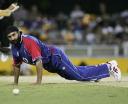Do you feel guilty about your fielding?
 Fielding is one guilt ridden pastime for most club cricketers. We feel bad because you don't practice it enough even though we know how important it is.
Fielding is one guilt ridden pastime for most club cricketers. We feel bad because you don't practice it enough even though we know how important it is.
Let's face it, fielding drills ain't as much fun as batting or bowling.
On top of this, the focus professionals have on their own fielding skills has generated a number of new fangled theories to improve further.
Do they work and are they a shortcut to improving your own skills so you don't have to feel guilty any more? Let's take a critical look at some of the in vogue ideas:
Walking in
The traditional walk in is under attack from such great fielders as Trevor Penny. The theory is twofold: First it is a waste of energy to take more than a couple of steps every ball. Second if you are walking at the moment the batsman hits the ball you are off balance and slower in the first step. While there is no real research on this, instinct suggests both theories to be correct. I aim to coach the walk as a way to focus your mind on the ball and be on the balls of your feet at the point of delivery, ideally in a low ‘ready' position like a football goalkeeper or tennis player.
Relay throws
This idea is taken from baseball. It's a superb way to get the ball back quickly if you have a weaker arm. Most club sides have players who can't get the ball from the deep in one go. It stands to reason that if another fielder goes halfway the ball can be relayed in two throws instead of one. I believe all colt and youth sections should coach this from day one so adults get into good habits.
Return to the keeper
Commentators hate this tactic. In top class cricket fielders return every ball to the keeper no matter what. It's designed to intimidate batsmen. I can't see how though. Whether it works or not it's certainly a bit much for the average club game. That said, I do like to see players throw the ball to the keeper to help with judging distance and power and to keep warm in the field. Every ball would be a bit much and there are bound to be overthrows. The watch word here is common sense. Throw it in now and again.
Bounce returns
In this world of reverse and converse swing, balls are thrown in on the bounce to rough up one side and encourage the ball to swing more. Again I can't see how this works. It's a tricky if not impossible task getting the ball rough on one side only by throwing it. I'm no bowler but I would stick to shining it and forgetting about bounce returns. The ball will be on the turf enough through throwers with weak arms anyway.
These are theories and opinions of course. Nothing is a provable fact. It's worth trying some of these strategies out. You may find they suit you.
But there are no shortcuts. If you are feeling guilty about your fielding it's not because you are using outdated theories, it's because you are not practicing enough.
Reader's homework
I'm interested in how are you going to improve your own fielding. Drop me a line with your plans and tactics, including how you are going to monitor your success. Over time we can build up a picture of what works and what doesn't.
- Login to post comments

